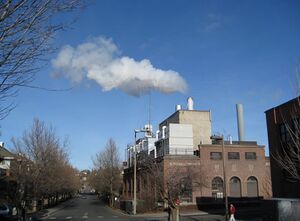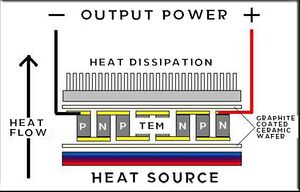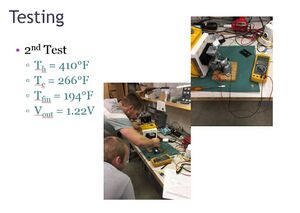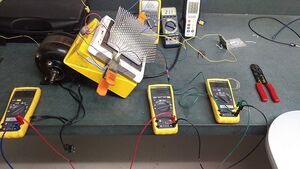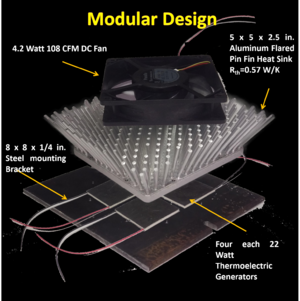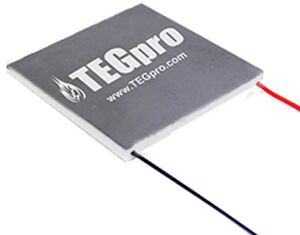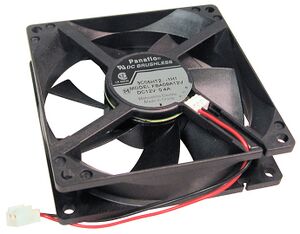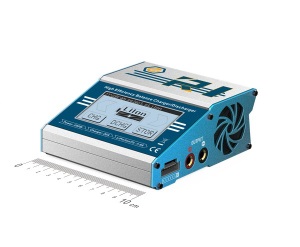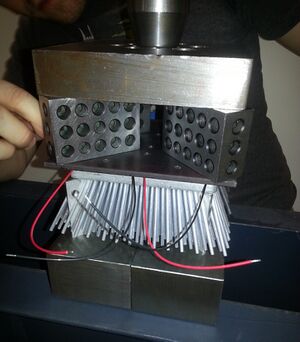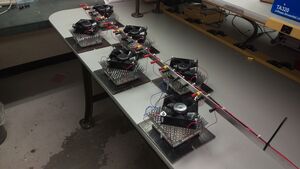Flue Gas Energy Recovery
| Flue Gas Energy Recovery | |
| Sponsor: | UI Facilities |
| Duration: | Fall 2016 - Spring 2017 |
| Team Name | Fire and Ice |
| Faculty Advisor: | |
| Consultants/Mentor: | |
| Team Members: | |
The steam plant at the University of Idaho has a large amount of waste heat that is expelled from many different surfaces. This is a common issue that occurs in many different power plants and industrial settings. Our solution is to capture a portion of this waste heat by utilizing Thermoelectric Generators (TEG). This is accomplished by achieving a temperature difference across the TEGs surfaces. As the ΔT across the TEGs increases, the power generation also increases. Flared pin heat sinks and electric fans are used to attain this temperature difference. Therefore, heat that would normally be wasted is now turned into power used at the steam plant.
Project Learning
Thermoelectric Generator
What is a Thermoelectric Generator(TEG):
How a TEG works:
|
Initial Design
Goals
- Be able to be applied to a wide variety of surfaces
- Maximize efficiency of the TEG by increasing the ΔT
- Minimize impact to existing structure or surface it is applied to
- Operate with little annual maintenance
- Apply to surfaces with a Temperature that is steady state
- Design an optimal way to provide the Cold side for the TEG
Specifications
- Desired TEG Wattage output (estimate): 40W
- Temperature range (based on applied surface):
- 1.Wood boiler exhaust: T_out=278°F to 285°F
- 2.Wood boiler flash hopper: T_out=500°F
- 3.Wood boiler outlet: T_out=280°F to 300°F
- 4.Wood boiler bottom ash hopper=250°F to 350°F
- Q necessary=500 to 800 Watts
Proof of Concept
For our teams initial testing we where able to get some TEGs from a past senior design project, some old heatsinks, and a hotplate from the chemistry department here at the University of Idaho.
| For test 1 we used a heat gun, heatsink and a thermal camera to get our hot and cold sides and to determine what the temperatures where on both. We felt as though there might be some error in the measurments because of the reflection on the thermal paper and using a heat sources that is radiation and not a hot surface.
| |
| For test 2 we where able to get a lot better test setup with a hot plate, thermocouples hooked up to multimeters and pressure applied to the TEGs. The results shown in each of the pictures to the right show a slightly better output with similar temperature differences.
|
Final Design
The wiring diagram below shows how everything will be installed at the steam plant, how the modules are put together, how the battery charger is used, and TB3 and TB4 show the wires run for thermocouples hooked up to 1 module for monitoring temperature.
| The test set in the picture shows a hotplate(Yellow with ceramic top) that the module is clamped to and connected to multimeters measuring Hot side temp, cold side temp, tip temp, voltage, and current. Out teams design for the Module we will be mounting to the side of the wood boiler at the steam plant. This design utilizes the items (TEGs, Heatsink and battery charger) shown below. | |
| The picture shows the break down of each module. The next several blocks will go over why each part was chosen and their features. | |
| The Tegpro TEG Power module is specifically designed for power generation from high temperature heat sources. Our Bi-Te based TEG Power module can operate continuously at 330 °C (626 °F) and intermittently up to 400 °C (752 °F). The Tegpro 22 Watt high temperature TEG Power module will generate power when a temperature difference is applied to the two sides. As the temperature difference becomes larger the efficiency increases. The module has highly conductive graphite sheets on both sides of the ceramic plates to provide low thermal resistance, therefore you will not need thermal grease or compound when the module is installed. The graphite sheet works well at high temperatures.(Info from tegmart.com)
Datasheet: TGPR-22W-7V Datasheet | |
Flared Characteristics
Datasheet: 3-505025G Datasheet | |
| After doing testing on several fans we found around the ECE senior design lab our team determined the way to use the fans for our project. Traditionally fan placed on heat sinks are oriented so that air is being pulled through the heat sink and pushing the hot air out of a case. For our project there is no where for the hot are to be blown out of so facing the fans inward and blowing air though the pins ended up producing a higher output. A fan with a higher velocity produced more output than a higher CFM. For these reason we choose this panifo fan because it was very efficient and had a very high velocity. | |
| The R1 is compact and intelligent battery charger with great features. The charger can charge up to 200W (20A)(The back-lit LCD touch screen makes the simple menu a breeze to navigate all charging / discharging options. This charger includes a multi-charge cable with many different connectors allowing you to charge just about any battery. Charge LiIon, LiPo, LiPo High Voltage, LiFe 1-6 cells or NiCd, NiMH 1-15 cells with this compact charger.(Info from getfpv.com)
|
Manufacturing
| For proper operation of TEGs a minimum of 900 pounds of press must be applied to them. This compresses the graphite sheets that they are coated and moves all surfaces as close as possible for maximum heat transfer. Static friction makes it nearly impossible to achieve this amount of force without the bolt heads shearing. As a solution our team came up with the idea of preload the device on a hydraulic press to the 900 pounds and then snugging the bolts down. Aluminum bars where placed in the parallel rows of the heat sink forming an X. This ensured the pins would not be damaged on the heat sink and also allowed the forced to be evenly applied on the module. | |
| The picture to the left shows all 6 modules assembled, wired up and connected to the cable tray. All six modules will be bolted to the side of the wood boiler in the steam plant on a surface that is 45 degrees. After they are bolted to the boiler to ensure the shortest amount of time is spent working next to it the cable tray will be bolted on to three different places and then each module has four plug. Positive and negative from the TEGs and positive and negative to the fan. This will ensure correct wiring and simplicity for doing the final install in the steam plant.
|
Team Information
Document Archive
Papers
Schedule
Design Review
- 2016 Design Review
- 2017 Detailed Design Review
- 2017 Bill of Materials
- Wiring Diagram
- ESS model
- Technical Presentation
- Final Report
- EXPO Poster
